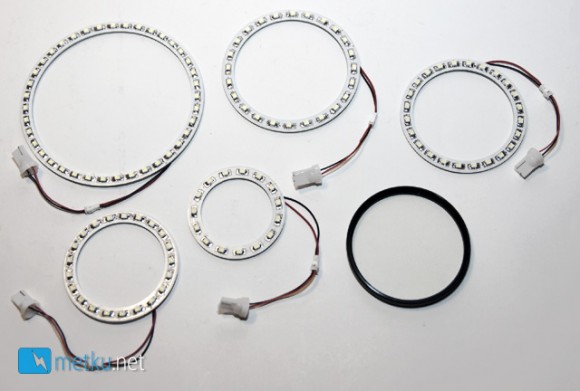Improve Your Photography with a DIY LED Ring Light

Ring light: a source of light for photography that encircles the camera lens completely. It creates a shadow-softening effect on the object or person being photographed, a warm and natural alternative to the stark standard camera-mounted single flash look. Normally the tool of professional photographers, ring lights are becoming more accessible to hobbyists, with models ranging from around $40 to well into the hundreds of dollars.
But for those of you who are taking macro or close-up photos, why not build your own? The cost of a DIY unit runs just over $25, and will take less than an hour to assemble. And the satisfaction of building the project on your own is impossible to match.
Jani ‘Japala’ Pönkkö of Metku.net pieced together a fantastic set of instructions using 12volt LED “eye” lights seen on current BMWs. By coupling a few together and mounting them into the lid of a CD spindle (like when you buy a 10 pack of blank CDs at Office Depot), you have a lighting system that can be mounted to a threaded adapter and screwed onto your favorite camera lens. Check his plans here.

Instructables user nygma2004 took the project one step further and wrote up plans for a 9v battery pack, conveniently tucked into a standard Altoids container. He’s using this as a way to get shots of his model railroad cars and locomotives – something I can identify with well. Read his how-to here.
Convenient, cheap lighting that gets great results. I love it.
You need the following:
– T10 21-LED White Light Car Angle Eye (70mm Diameter) from Dealextreme
– T10 24-LED White Light Car Angel Eye (90mm Diameter) from Dealextreme
– T10 39-LED White Light Car Angel Eye (120mm Diameter) from Dealextreme
– Big Altoids peppermints box from local supermarket
– Old laptop power supply “borrowed” from work
– 3.5 mm stereo plugs and socket, 3 each. I used a socket which has screw mount, so it is easy to fit into the box.
– 2.5 mm DC socket that fits your power supply plug
– TS7812 1A 12V fixed voltage regulator
– 9V battery clips
– Adapter ring, my Canon ESO 300D has 58mm ring (easily found for Nikon, Pentax and all the other DSLR makes)
– Some cable






